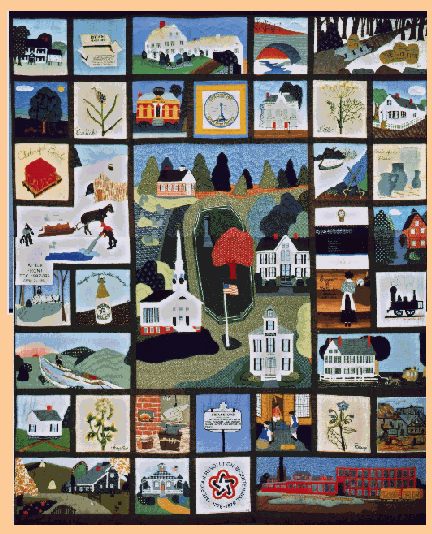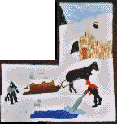
Chelmsford Bicentennial Quilt 1976
This hand-crafted quilt made by local residents hangs in a place of prominence within the library, at the entrance to the McCarthy Meeting Room.

Each block on the quilt represents something unique from Chelmsford’s history. The following descriptions for the quilt blocks were written in 1976 by the Bicentennial Club of the McFarlin School under the direction of Ms. Janice Carragher and Ms. Virginia Blouin. They were assisted by sixth grade students Terry Cryts, Sirry Karlsson, Melissa Micol, Susan Burns, Judy Fahey, and Kim McBride in 1976.
Waite House
This 18th Century brick-ender in South Chelmsford was built by John Bateman, whose daughter Charlotte married Ezekiel Byam, the match manufacturer.
Match Box
The first Lucifer Matches were made in South Chelmsford by Ezekiel Byam in 1835. The old match shop stood on Robin Hill Road, a granite marker now marking its site.
 Barrett-Byam House
Barrett-Byam House
Located on Byam Road, is the headquarters and museum of the Chelmsford Historical Society and is one of the oldest homes in Chelmsford.
Granite Quarry
In the early 19th century granite quarried in Chelmsford supplied stone for some of the major construction in the area, including the arch over the Middlesex Canal depicted here.
Lime Quarry
Lime was quarried for many years in Chelmsford at a site a little west of the Center on Route 110.
 Apple Orchard
Apple Orchard
In rural Chelmsford, apple orchards were a prominent feature of the countryside and important to most farmers.
 Garlic
Garlic
Was a plant widely used in early times in cookery and medicine.
 Adams Library
Adams Library
Was build in 1984, dedicated in 1895, and named in honor of Amos F. Adams who donated the funds for its construction.
 Chelmsford Town Seal
Chelmsford Town Seal
Depicts the Revolutionary War Monument and town motto “Let the Children Guard What the Sires Have Won.”
 I.O.O.F. Building
I.O.O.F. Building
Now occupied by the First Bank and Trust, at the turn of the century it housed the E. T. Adams Store and a bakery on its first floor. The Odd Fellows Hall on the second story was used by St. Mary’s Parish for Sunday Mass before construction of a church.
 Dill
Dill
Was an important herb to rural housewives for pickling.
 Old Mill House
Old Mill House
Located in Chelmsford Center, is an early building connected with the mill complex on Beaver Brook which dates back to the 17th century, including both grist and saw mill operations. For over thirty years Miss Ruby Emery and Miss Rose G. Meserve operated a bakery here that was famed for its home-baked delicacies.
 Chelmsford Brick
Chelmsford Brick
Was once manufactured in East Chelmsford on Brick Kiln Road. The 1802 School House was made from these bricks as well as many of the older houses in town.
 Ice Harvesting
Ice Harvesting
Was an important occupation in early Chelmsford during winter months.
 1802 School House
1802 School House
Was constructed of brick from East Chelmsford to replace the original school house on this site, dating to 1718.
 Scythe Factory
Scythe Factory
Located in West Chelmsford, was established in the 1820’s. During the Civil War the manufacture of swords replaced scythe making.
 Chelmsford Glass
Chelmsford Glass
Was manufactured at a glass works in Middlesex Village, established in 1802. The Barrett-Byam Museum has an extensive collection of Chelmsford glass.
 Revolutionary War Monument
Revolutionary War Monument
Was erected on the Common in 1859, in honor of the townsmen of Chelmsford who served their country in the struggle for independence.
 School for the Deaf
School for the Deaf
In 1865, Miss Harriett Burbank Rogers founded the first oral school for deaf children in the Deacon Otis Adams House on Academy Street. Here five pupils were instructed in “articulation and reading from the lips.”
 Susan McFarlin’s classroom
Susan McFarlin’s classroom
Susan McFarlin taught the youth of Chelmsford for almost half a century at the old yellow school house in the Center, where the fire house stood for over 50 years.
 Russell Mill
Russell Mill
In 1656, the first saw mill in Chelmsford was located at what is now known as Russell Mill Pond by Samuel Adams and maintained by five successive generations of his family.
 Pulpit Rock
Pulpit Rock
Rev. John Parkhurst, a minister in Chelmsford in the early 1800’s used to practice his sermons at Pulpit Rock on Robin Hill.
 Chelmsford Ginger Ale
Chelmsford Ginger Ale
In 1901, the Chelmsford Spring Co. was established in the Center for the manufacture of ginger ale and other beverages. The plant was purchased by Canada Dry in 1928.
 Forefathers Cemetery
Forefathers Cemetery
Contains the graves of many of the earliest settlers of Chelmsford and the graves of forty-five Revolutionary War soldiers.
 Beech Tree
Beech Tree
Was planted on the Center Common in 1891, by the graduating class of Chelmsford High School.
 Locomotive
Locomotive
Pictured is the sixth locomotive of the Nashua-Lowell Railroad’s Lion train, which started running In 1838. After departing from its Lowell depot at the corner of Merrimack and Dutton Streets (old YMCA now on site) it made two stops in Chelmsford — one at Middlesex Village at Baldwin Street and a second in North Chelmsford Center.
 Middlesex Canal
Middlesex Canal
Linked the ocean at Charlestown with the Merrimack River at Middlesex Village, its operation thriving during the first three decades of the 19th century. After its opening in 1803, it offered cheap transportation of goods between Concord, New Hampshire and Boston.
 First Parish Church
First Parish Church
Was constructed in 1842 and is the fourth church to stand on this site.

Town Hall
Was constructed in 1879, with an original appropriation of $7,000.
 Fiske House
Fiske House
In Central Square was built in 1798 by Simeon Spaulding, Jr. In the late 1830’s Thomas Moore operated it briefly as a tavern called the Lafayette House. In April 1839, it was purchased by John Minot Fiske and has since remained in the Fiske family.
 Middlesex Canal Toll House
Middlesex Canal Toll House
Stood at the landing at the head of the canal in Middlesex Village.
 Angelica
Angelica
Was cultivated for its aromatic odor, its medicinal roots, and for its stalks, which were candied and eaten.
 Blacksmith
Blacksmith
The blacksmith and his forge were essential in a farming community for the tools he fashioned as well as shoeing of horses.
 Chelmsford Sign
Chelmsford Sign
Is the historic marker in Chelmsford Center, commemorating the original settlement of the town in 1653.
 Minutemen and British Prisoners
Minutemen and British Prisoners
Chelmsford was selected to quarter prisoners of war during the Revolution because it was far enough away from the battle lines.
 Borage
Borage
A hairy-leaved herb, was used medicinally and in salads.
 Perham Cider Mill
Perham Cider Mill
Was located on Westford Street from 1835 until it was destroyed by the construction of Route 495. Local apple growers brought their product for processing into cider and vinegar for S.S. Pierce.
 Garrison House
Garrison House
Was constructed between 1683 and 1690. During the threat of Indian attack, the house served as a garrison for soldiers.
 Summit House
Summit House
A popular “resort” located at the top of Robin Hill, was opened in 1886, by Walter S. Simonds. Its pleasant view and tasty treats made it a popular destination for summer carriage drives during the 1890’s.
 Bicentennial Logo
Bicentennial Logo
Is the symbol for the commemoration of the 200th anniversary of America’s Declaration of Independence.
 Southwell Combing Mills
Southwell Combing Mills
Along with its predecessors in North Chelmsford have been one of the town’s major industries since the 19th century.
Names Behind the Quilt
The Chelmsford Revolutionary War Bicentennial Commission expresses its gratitude to all the citizens who gave of their time, talents and skills to create the Town of Chelmsford Bicentennial Quilt.
Chelmsford Bicentennial Quilt Committee
Mary J. Guaraldi – Chairman
Sally Palmer Field – Advisor
Margie Moler – Design Chairman
Irene Pouliot – Fabric Selection Chairman
Prue McBride – Fabric Selection Co-Chairman
Mrs. Malcolm Weeks – General Assistant
Elizabeth A. McCarthy – Publicity Chairman
The Names
The following is a list of names from the original booklet of those people who were involved in the Bicentennial Quilt Project:
Margaret E. Adams
John Alden
Joanne Allard
Janice Baird
Helen Barris
Robert Barris
Betty Belanger
Eleanor Bragdon
Audrey Carragher
John Carragher
Mrs. Francis L. Clancy
Lorraine Clark
Val Clark
Jane Drury
Brenda Dudley
Mrs. Henry Emmons
Eleanor Ferreira
Virginia Fielding
Nancy Fiske
Eustace Fiske
Julia Fogg
Irene Foster
Louise Fulton
James Geary
Robert Geary
Jeanne Glenfield
Catherine Goodwin
George L. Guaraldi, Jr.
Walter Hedlund
Mrs. William C. Hinckley
Burt Hood
Mary Hubbard
Bill Hynes
Judy Hass
Natalie Jones
Vincent Kehoe
Carol Kennealy
Mrs. Jean E. Kilburn
Mrs. Richard O. Lahue, Sr.
Richard O. Lahue, Sr.
Elizabeth Ann Lombard
Janet Lombard
Sandra Ludwig
Charles Maderosian
Jean Mansfield
J. Michael McBride
Joyce McKenzie
Ann Meeker
Helen Monahan
Dr. Howard Moore
Fran Murphy
Ann Normand
Mrs. Edward Norton
David Panciera
Eleanor Parkhurst
George A. Parkhurst
Mrs. Ralph S. Parlee
Mary Partridge
Robert Picken
Mrs. Helen Poland
Ernest Pouliot
J. Perry Richardson
Betty Ripsom
Marjorie Sargent
Connie Scarth
James Scarth
Judy Seredynski
Clara Sills
Mary Slattery
Chris Stavros
Hazel Stevens
Marilyn Supple
Mrs. Charles E. Watt
Dot Webb
Linda Webb
Roger Welch
Barbara Willman
Kathy Willman
Hedy Zaberick
Special Thanks To…
The Library wishes to thank the Chelmsford Cultural Council for its part in having the quilt cleaned and preserved by the Textile Conservation Center at the American Textile History Museum in Lowell so that future generations may view it in the new library.
Thanks to the
Massachusetts Cultural Council
Thanks also to the Chelmsford Historical Society which supported this project.






